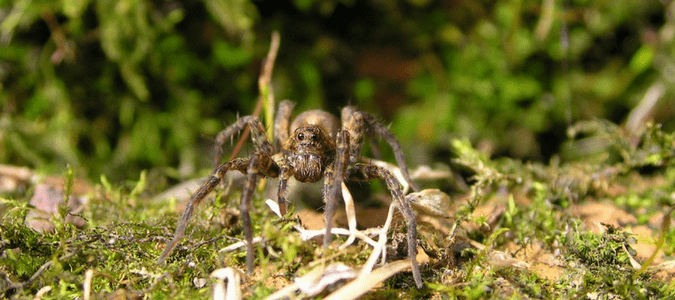
According to Texas Parks & Wildlife, almost 900 species of spiders are found in Texas. Only two, however, are considered poisonous to humans: the black widow and the brown recluse spider. While there is much to learn about the danger associated with the two aforementioned spiders, there is another, more commonly seen spider in Texas. You also may not know much about the wolf spider.
What You’ll Learn:
- What Should I Do If I See A Wolf Spider?
- What Do Wolf Spiders Eat?
- Where Do Wolf Spiders Live?
- How Do Wolf Spiders Reproduce?
- Are Wolf Spiders Poisonous?
What Should I Do If I See A Wolf Spider?
How likely are you to come across a wolf spider in Texas? An old saying is, “you’re never more than five feet from a spider.” Although this has been disproved, the truth is that there are spiders all around us, and there are 238 species of wolf spiders in Texas alone. That’s a lot of spiders potentially hiding in your lawn!
The most notable characteristic of a wolf spider’s appearance is its unique eye arrangement. The front (or anterior) row comprises four small eyes of roughly the same size and is arranged in a straight row. Above that row rests two more enormous eyes; two smaller eyes are found above the middle row. This spider has a total of eight eyes.
Another notable aspect of this type of spider’s physical appearance is the two sharp horizontal fangs at the bottom of its jaws. The jaws, also known as chelicerae, are used to hold the spider’s prey, inject venom and eat.
Like other spider species, the wolf spider has a two-segmented body and eight legs. This species ranges in color from brown, gray, black, or tan and has dark markings that resemble stripes. And because they’re nocturnal animals, their coloring is effective camouflage.
What Do Wolf Spiders Eat?
Unlike most other spiders, wolf spiders are predators. That means they don’t catch prey with their webs but instead go out and search for food. The definition of predator typically indicates a fast-moving, ruthless animal. But when referencing the wolf spider, it simply means they aren’t passive. Instead, the wolf spider seeks new locations and waits for their prey. When they’ve had enough, they pick up and move to a new location, often traveling great distances.
As stated above, wolf spiders are nocturnal and hunt their prey at night, mainly eating ground-dwelling insects and other spiders. And while some wolf spiders jump on their prey, others hold and trap it between their legs before biting it using their two horizontal fangs.
Where Do Wolf Spiders Live?
It’s not just Texas that wolf spiders call home. Because they travel for food, wolf spiders can be found in many regions worldwide and in habitats. As a result, they have one of the most diverse distributions of all spiders. Still, despite their nomadic lifestyle, pest control professionals know to look for wolf spiders in and around homes or garages—especially during the colder months.
Another distinguishing characteristic of this spider species is that they don’t spin webs. Instead, they reside in burrows. The wolf spider sometimes seals the burrow with silk during the rainy months and plugs the burrows with rocks and pebbles to keep the water out. Because of this fondness for burrowing, consider investing in landscaping work for proactive defense against these habitats.
How Do Wolf Spiders Reproduce?
Males wave their pedipalps (the short, sensory appendages near the mouth) in particular patterns or bang them together to show the female their interest. And though the male spider approaches a female spider, often attracted to her scent left by her dragline silk, the female has the last say. Aggressive in nature, females may accept the male’s advances or push him away.
Mating occurs at night. After mating, the female constructs an egg sac made of white papery silk and carries the eggs on her spinnerets. When the eggs hatch, the mother will continue carrying her babies on her back until they are ready to disperse. It should be noted that this high level of parental care is relatively uncommon amongst other spider species.
Are Wolf Spiders Poisonous?
Since we previously talked about its fangs, you’re likely wondering: do wolf spiders bite, and are they venomous? The main thing you need to know about wolf spiders is that they cause little harm to humans. If threatened, they will bite and inject venom, but this happens only on rare occasions. If bitten, humans will only experience some swelling, mild pain, and itching in the infected area. If the symptoms don’t go away in a few days, though, it’s best to seek medical care for treatment.
In more rural, agricultural areas, the wolf spider is appreciated for its role in its ecosystem. Since wolf spider prey on other insects, they can help keep other insect populations at bay.
Pests Are No Match for ABC
If you are having trouble identifying what type of spiders have taken up residence in and around your home, it’s best to call the spider pest control experts at ABC Home & Commercial Services. Our team of experts is well-trained and able to identify any pests and give you suggestions on how to treat any wildlife infestation, big or small. Call us, and we’ll create a customized approach to best treat the situation to ensure your home is pest-free.